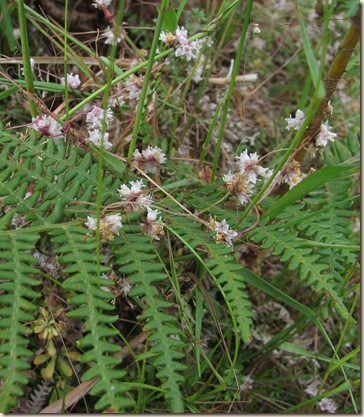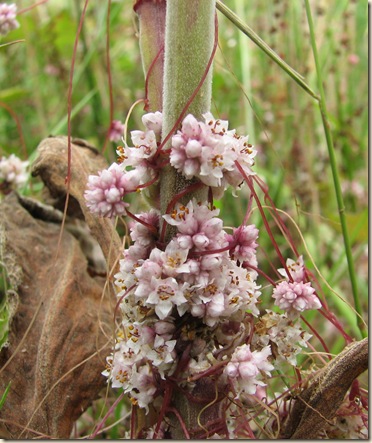Common dodder, Cuscuta epithymum, is a low-growing parasitic plant with red, thread-like stems and pink flowers in summer. It was first recorded in Brede High Woods in 1994 in a small open area (TQ790202) that is part of what was known in pre-reservoir days, i.e. before 1930, as The Hothes (now part of Compartment 4b), indicating a rough grazing area of gorse and heath. It is currently normally referred to as ‘Sedlescombe Heath’. Dodder was parasitic on heather, Calluna vulgaris, here, but will also use a wide range of other plants as host, such as wood sage, bracken, bramble and various grasses. It has even been found on lousewort, Pedicularis sylvestris, which is itself partially parasitic.
It was described as common in Sussex by Arnold in 1887, but had become relatively scarce by the time Hall’s Sussex Plant Atlas was published in 1980. Currently its main East Sussex locations apart from Brede High Woods are Ashdown Forest, Chailey Common and Hastings Country Park and it was also widespread on the Downs in the past, but it continues to be a generally declining plant. The Online Atlas of the British and Irish Flora says “The loss of lowland heath, ploughing of chalk downlands, and an increase in scrub have caused a decline in this species since 1930.” Whilst it is still locally abundant in southern England, distribution maps suggest a continuing substantial decline.
In the early years of the 21st century it disappeared from its only known location in Brede High Woods, but another patch was discovered in 2009 some 200 metres north of the original site. Following clearance of conifers and broadleaves from formerly open areas in late 2009 it appeared in some abundance in 2011, particularly in the southern part of 4b that had been an oak plantation and it was also found in Compartment 5a where there had been dense conifer cover for many years.
It is well known that seed can retain viability under unfavourable conditions for many years (Meulebrouck, 2009) and it will often, though not always, colonise fire sites in the heathlands where it grows (Rich et al., 1996).
Dodder only flourishes in the early successional stages of heathland and other habitats and management is important in ensuring its long-term survival. Meulebrouck (2009) recommends for Belgian heathlands “a combination of cyclical management by mowing, burning and shallow turf cutting” with seven- or ten-year management cycles on patches containing dodder, a technique that can be successful even at small scales.
Meulebrouck further points out that livestock grazing is an important management measure for lowland heaths. The positive effect of extensive grazing on both the presence of dodder populations and the long-term metapopulation viability, indicates that grazing is a beneficial and valuable conservation tool for dry heathlands. A mosaic of pioneer phase patches of heathland regeneration are not only important for dodder, but for other plants and their associated faunas that flourish in bare, or thinly vegetated, open habitats.
REFERENCES
Arnold, F. H. (1887) Sussex Flora. Hamilton, Adams & Co, London
BSBI et al. (2011) Online Atlas of the British and Irish Flora. http://www.brc.ac.uk/plantatlas/index.php?q=plant/cuscuta-epithymum
Meulebrouck, Klaar (2009) Distribution, demography and metapopulation dynamics of Cuscuta epithymum in managed heathland. Doctoral thesis for the Catholic University of Leuven, Belgium. http://dfwm.ugent.be/lavobo/docs/Doctoraten/Klaar_Meulebrouck_doctoraat.pdf
Rich, T., Donovan, P., Harmes, P., Knapp, A., Marrable, C., McFarlane, M., Muggeridge, M., Nicholson, R., Reader, M., Reader, P., Rich, E. & White, P. (1996) Flora of Ashdown Forest. Sussex Botanical Recording Society.

